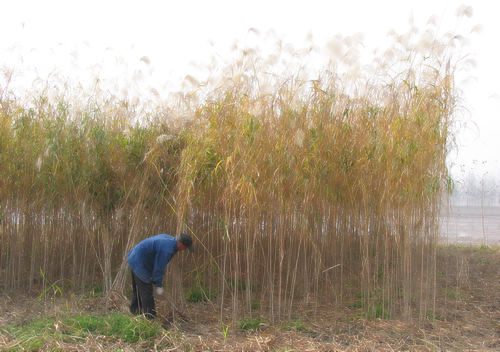Variability and Adaptability of Miscanthus Species Evaluated for Energy Crop Domestication
2011-06-17
A growing body of evidence indicates that second-generation energy crops can play an important role in the development of renewable energy and the mitigation of climate change. However, dedicated energy crops have yet to be domesticated in order to fully realize their productive potential under unfavorable soil and climatic conditions. It is a new project to accelerate the domestication of second-generation crops, using the natural plant resource.
Coupled with Institute of Botany, CAS and Shanghai Institutes for Biological Science, CAS LI Jiangqiang’s group in Wuhan Botanical Garden explored the possibility of domesticating Miscanthus crops. Almost one hundred Miscanthus populations were collected across their natural distributional ranges in China and grown in three locations that represent temperate grassland with cold winter, the semiarid Loess Plateau, and relatively warm and wet central China. According to investigation and data analysis, the wild species harbored a high level of genetic variation and adaptive plasticity, which could provide valuable resources for the development of energy crops with tolerance to cold, drought and barren soil. The study was published on line in Global Change Biology Bioenergy. The journal specially released the press on June 6, 2011, which has aroused extensive concern (e. g., AAAS EureAlert, AlphaGalileo, ScienceDaily, Cell Press News Aggregator, sciencenewsline nature).
Quote: Press-release-----"Miscanthus Adapts" (Source: Eurekalert)
An article in the current issue of Global Change Biology Bioenergy finds that natural populations of Miscanthus are promising candidates as second-generation energy sources because they have genetic variation that may increase their stress tolerance.
Sustainable, large-scale bioenergy production requires domestication that develops crops capable of producing sufficiently high biomass on marginal and degraded land.
Yan and coauthors collected three species of Miscanthus from populations across China and grew these species at three separate sites with varying climates to evaluate their growth. The authors found that wild populations of Miscanthus have high levels of genetic variation and adaptation that could provide valuable resources for the development of second-generation energy crops.
According to Professor Sang of the Plant Biology Department at Michigan State University, the Director of the Key Laboratory of Plant Resources at the Institute of Botany, Chinese Academy of Sciences, "The domestication of food crops began approximately ten thousand years ago, partly in response to climate change following the last glacial maximum. Today another round of domestication for energy crops may be necessary for the sustainability of our society. In this study, we found that wild Miscanthus species native to China have the potential to become high-yield energy crops capable of growing on marginal land. The domestication of Miscanthus should be an equally exciting, but much shorter, journey in comparison to food crop domestication."
Researchers are encouraged by these findings because in order for bioenergy crops to not compete with food production they will have to be grown on land with poor soil quality and little irrigation. Miscanthus continues to have potential as a bioenergy crop because of its high biomass yield in regions that are colder and drier than its natural habitats.

Cultivating population of Miscanthus(Image by YAN Juan)